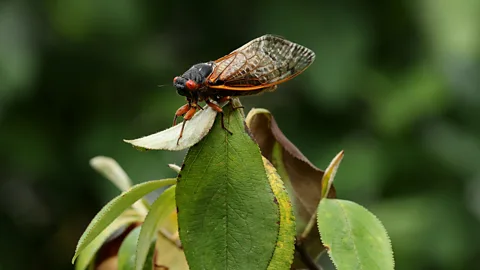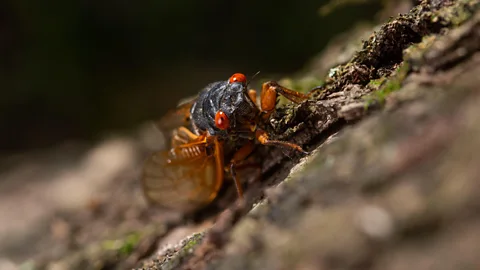Cicada dual emergence brings chaos to the food chain
 Getty Images
Getty ImagesWhen trillions of periodical cicadas emerge in a rare double event, they provide a disruptive feast for other species.
This April, trillions of periodical cicadas began their descent on the midwest and southeast of the United States, causing so much noise that local residents called the police to complain. But the cicadas don't just disrupt neighbourhoods with a deafening soundtrack, they also throw food chains into chaos.
After spending more than a decade burrowed underground sipping on tree root juices, two broods – Brood XIII and Brood XIX – are emerging at the same time in 2024: the first time they have done so simultaneously since 1803.
Such emergence of the insects en masse will disrupt ecological food systems, says Grace Soltis, a PhD student studying evolutionary biology at Florida State University.
"Cicada emergences can completely rewire a food web," says Soltis, who co-authored a paper studying the cascading impacts of bird predation on cicadas during the 2021 Brood X emergence. "For predators, these emergences are a huge boom in resources. It's basically like an all-you-can-eat buffet for the hungry predator."
The emergence would not directly impact the human food system, Soltis adds, but unusually high levels of cicadas aren't good news for all. So scientists are capitalising on 2024's dual emergence to find out more about the insects' ripple effect on other species, both in the animal kingdom and in plants.
 Getty Images
Getty ImagesPeriodical cicadas have an incredibly lengthy life cycle, unlike their non-periodical brethren which mature each summer. After hatching, the immature periodical cicadas, called nymphs, spend either 13 or 17 years underground, feeding on roots, before squirming their way upwards and transforming into adults.
The 17-year Brood XIII, which hatched in 2007, is due to emerge in Northern Illinois, and the 13-year Brood XIX will emerge in parts of the southeastern US. Both events began, as predicted, in late April 2024.
The insects will provide a lavish banquet for all kinds of wildlife. Birds of all shapes and sizes – sparrows, crows, swallows, to name a few – opportunistically shift their diet to take advantage of this cicada buffet. A study, published in 2023, found the emergence of periodical cicadas changes the diets of entire bird communities.
Cicadas' zombie STD
A fungal parasite, Massospora cicadina, is infecting periodical cicadas and causing them to act in bizarre ways – namely, having sex until they fall apart and die.
It is not known exactly when the cicadas are exposed to the fungal spores, but the fungus builds up in their abdomens, eventually causing the male insects' genitals to fall off. A chalk-like, gumdrop-shaped cluster of spores emerge in the place where the genitals once were.
In both genders, the fungus manipulates the cicadas' behaviour, turning them into "zombie" insects and causing the infected insects to frantically attempt to mate. The dis-embowelled male eventually dies, but not before scattering the fungal spores over other cicadas – earning them the moniker "saltshakers of death".
"The fungus and the cicadas have a long evolutionary history," says John Cooley, a biologist at the University of Connecticut. "I don't think the fungus will eliminate them."
Mass cicada emergences can cover up to 190,000 sq mi (500,000 sq km), says John Lill, professor of biology at George Washington University's department of biological sciences and another co-author on the cascade paper. As a result, this diet shift causes a ripple effect down the food chain: "It's a pretty substantial disruption across a whole landscape," he says, "generalist predators switch over to feeding on this bounty of food".
Scientists have found that wild turkeys, for example, will capitalise on the bounty, leading to a wild turkey boom. Shrews, a small mole-like mammal, also dine on cicadas, as do bats, spiders, wasps, and even snakes, says Lill.
But it's birds that are most obviously impacted by the disruptive effects. Soltis and Lill's study found more than 80 species of birds switched their diets to cicadas during the 2021 emergence.
What the birds weren't eating was just as important as what they were, the scientists realised. A ripple effect ensued; caterpillars, usually preyed on by birds, were left off the dinner menu and their numbers more than doubled. This in turn led to damage to trees caused by out-of-check caterpillar populations.
"There's consequences for the food web because of all the things that go uneaten," says Lill.
 Getty Images
Getty ImagesWhat will be the long-term effects of 2024's cicada bonanza?
How long it takes for the food chain to settle down again and return to the status quo is still not quite understood, Lill says. The birds switch back their diets immediately after the cicada emergence ends, but because there is so much food available the bird populations increase. The following year, when food source isn't as plentiful, there is a knock-on effect.
"There have been relatively few studies documenting long term bird data when it comes to cicada emergences," Lill explains.
Emergence events only last around five to seven weeks, but offer a rare opportunity for scientists to assess the impacts of an "resource pulse" – the name for a large amount of increased resource over a short duration of time. Cicadas are known to stimulate soil nutrient cycling, partly due to their carcasses decomposing and releasing nutrients, and also due to the emergence-holes they create which boost water infiltration into the soil. But despite this, relatively little is known about the real-time effects of living cicadas on food webs.
More like this:
- How I tempted a frog to live in our garden
- Insects: a neglected protein-rich 'superfood'
- How bird flu became an animal pandemic
And climate change will ensure scientists are kept on their toes when it comes to monitoring the impacts of cicada emergence. The creatures have evolved through substantial periods of climate change, and scientists predict they will continue to adapt to a warming climate.
Rising temperatures will lead to periodical cicada emergences starting earlier in the year, experts believe, as well as an increase in unexpected, "oddly-timed" emergences.
"The effects of climate change on cicadas and their food webs remain to be seen," says Soltis. "I hope we can collect more data on this during these emergences."
--
For essential climate news and hopeful developments to your inbox, sign up to the Future Earth newsletter, while The Essential List delivers a handpicked selection of features and insights twice a week.